07.12.2006
Kramnik vs Deep Fritz. Games 4-6 annotated K.Sakaev
DEEP FRITZ – V.Kramnik (2750) [C43]
Game 4, 01.12.2006
1.e4 e5 2.¤f3 ¤f6 3.d4 ¤xe4 4.Ґd3 d5 5.¤xe5 ¤d7 6.¤xd7 Ґxd7 7.0–0 Ґd6 8.Јh5 Јf6.

Almost a novelty. To be more precise this move was played a couple of times in the games of little known players. Of course the queen's sortie is very concrete and it's impossible to evaluate it without a help of computer but undoubtedly Vladimir resorted to this help when preparing this line.
9.¤c3. So far the d5 pawn is poisoned: 9.Јxd5 Ґc6 10.Јc4 0–0–0 11.Ґe3 (11.¤c3? simply loses: 11...Ґxh2+! 12.ўxh2 ¦xd4 13.Јb3 ¤c5, and the dreadful blow on g2 is unavoidable) 11...Ґf4 (also interesting is 11...¦he8 or even 11...Јh4 – with an initiative in both cases) 12.¤c3 ¤xc3 13.Ґxf4 ¦xd4 14.Јxc3 Јxf4, and Black's position is somewhat more active.
9...Јxd4. 9...¤xc3 10.bxc3 isn't good as Black has to part with either the d5 pawn or the castling.
10.¤xd5. 10.Ґe3 looks more natural but the computer calculated the following line: 10...Јe5 11.Јxe5+ Ґxe5 12.¤xd5 ¤f6 13.¦ae1 ¤xd5 14.Ґd4 (14.Ґd2 f6 15.f4 ¤xf4 16.Ґxf4 0–0 17.Ґxe5 fxe5 18.Ґc4+ ўh8 19.¦xf8+ ¦xf8 20.¦xe5 ¦e8 leads to a draw as well) 14...0–0–0 15.Ґxe5 (15.¦xe5 ¤b4) 15...¤b4 16.Ґxg7 ¤xd3 17.cxd3 ¦hg8 18.Ґf6 Ґc6! with a draw.
10...Ґc6. I noticed that in the line which begins with 7...Ґd6 the light-squared bishop often enters to c6.
11.¤e3. The pawn sacrifice 11.¤c3?! is hazardous in view of 11... ¤xc3 12.bxc3 (the exchange line leads to yet another draw: 12.¦e1+ ¤e4 13.Ґxe4 Ґxe4 14.Јg4 0–0 15.Јxe4 Јxe4 16.¦xe4 ¦fe8, ит.д.) 12...Јxc3 13.Ґg5 ўf8 14.¦ae1. White has some compensation but it's barely sufficient as there are no weaknesses in Black's position, his bishops are splendidly placed while the rook h8 will enter the game at some point with the help of an accurate advance of the h and g pawns.
11...g6. It's dangerous to allow the knight to come at f5: 11...0–0 12.¤f5 Јe5 13.f3 ¤f6 14.Јh4 with a menacing initiative.
12.Јh3. To provoke Ґe7 by the in-between 12.Јh4 is pointless as on d6 the bishop would be exposed to ¤c4.
12...¤g5. Following his general strategy Vladimir Kramnik is seeking after simplifications.
12...0–0 would be a mistake in view of 13.¤c4! Now it's not desirable to provide White with the bishops pair while 13...Ґe7 is a loss of an important tempo: 14.Ґe3 Јf6 15.f4! White secures the e5 square for his knight at the same time threatening with f4-f5. Black's defence is difficult.
To play by bishops would be unwise: 12...Ґc5 13.¤g4! (the eccentric 13.¤d1 0–0 14.Ґe3 Јd6 doesn' t yield dividends) 13...h5 14.Ґxe4 hxg4 (risky is 14...Ґxe4?! 15.Ґe3 hxg4 16.Ґxd4 gxh3 17.Ґxh8 0–0–0 18.¦fe1 f5 19.Ґc3) 15.Ґxc6+ bxc6 16.¦e1+ followed by Јh3-e3, liquidating into a slightly better ending.
But Black himself could start the bishop hunting: 12...¤c5!? 13.¦e1 0–0, and he isn't worse.
13.Јg4

13...Јf4? This simplification is aiming at the bishops exchange in addition to the swap of queens. Nevertheless it deteriorates Black's position significantly. 13...Јxg4 14.¤xg4 ¤e6 15.¦e1 0–0–0 led to a complicated ending with many tactical subtleties where Black's counterplay would be quite enough to maintain the balance. Now he is forced to switch over to the cheerful defence.
14.Јxf4. 14.Јg3 Јxg3 15.hxg3 ¤e6 16.¤c4 0–0–0 keeps merely a microscopic edge. The knight on e6 is placed very well restricting the white dark-squared bishop.
14...Ґxf4 15.¤c4 ¤e6 16.Ґxf4 ¤xf4 17.¦fe1+ ўf8 18.Ґf1. In spite of the reduced material Black is in serious trouble as he hasn't completed development comfortably and his rooks remain separated.
18...Ґb5. To 18...ўg7 strong is 19.¤a5 with a positional threat of the bishop's trading. Had the computer played with Black it wouldn't miss a tactical trick 18...Ґd7!? 19.¦ad1 ¦e8!
19.a4. Weaker is 19.¦e5 Ґa6 20.b4, and the rook's position allows Black to gain a tempo – 20...f6!
19...Ґa6 20.b4. 20.¤a5 Ґxf1 21.ўxf1 ўg7 22.b3 ¦ab8 23.¦ad1 ¤e6 looks less consistent. Black should hold here although his position is rather unpleasant.
20...Ґxc4. Black is forced to give up the bishop and White's advantage becomes tangible.
21.Ґxc4 ¦d8 22.¦e4 ¤h5 23.¦ae1 ¦d7 24.h3?!

Well this is the way it guards the back rank! I can't say it spoils something but there an axiom for such positions that the pawns should be put on the dark squares. Of course 24.g3 would display more competence moreover I would call a4-a5 a useful move. So far the computer lacks a depth of calculation to take a rather simple positional decision.
24...¤g7. Vladimir skillfully regroups his pieces.
25.¦e5. 25.g4 would allow Black to bring the rook h8 into action by 25...h5 at the same time constricting the front eliminating the h-pawns. In the bishop vs knight play such exchanges favour the side that has the knight.
25...¤f5 26.Ґb5! Finally we can praise the silicon player for a good positional decision – c7-c6 provoked by this move certainly weakens Black's position. 26...c6. Black can't take the rook away from the 7th rank as then White plays g2-g4, and his rook will get into Black's rear.
27.Ґd3 ¤d6 28.g4?! Played in the same key as 24.h3?! The continuation 28.f4 ўg7 29.ўf2 ¦hd8 30.g3 looks normal preserving a durable edge. A keen reader may learn how to win such a position with White by playing through the famous game Fischer – Taimanov that has become a classical pattern.
28...ўg7 29.f4 ¦hd8 30.ўg2 ¤c8 31.a5 ¦d4 32.¦5e4. Had the f4 pawn been protected (for this it was enough to play g2-g3 instead of g2-g4) White could have pushed the b-pawn now creating new weaknesses in Black's camp on the queenside.
32...ўf8 33.ўf3 h6! Naturally Vladimir Kramnik is not a computer and he wouldn't put the pawn on the light square by a7-a6.
34.¦xd4 ¦xd4 35.¦e4 ¦d6! The rooks should be traded only after some more pawns are placed on the dark squares.
36.ўe3 g5! Now White has nothing to hope for on the kingside thus only the queen's flank is left.

37.¦d4?! White doesn't on the queenside either. After 37.c4 Black would still had some problems 37...b6 (more reliable is 37...¤e7 38.f5 ¤g8 39.a6 bxa6 40.¦e5 ¤f6 41.¦a5 ¦d7 42.¦xa6 ¦c7 but here White exerts certain pressure yet) 38.c5 bxc5 39.bxc5 ¦d5 40.fxg5 [inferior is 40.¦b4 gxf4+ 41.ўe4 ¤e7 42.¦b7 ¤g6, and the f4 pawn suddenly becomes terribly strong: 43.¦xa7 ¦e5+ 44.ўd4 ¦d5+ 45.ўe4 (45.ўc3 ¦xc5+ 46.ўb4 ¦c1 isn't dangerous either) 45...¦e5+ with a draw] 40...hxg5 41.¦b4 ¦xc5 42.¦b8 ¦e5+ 43.ўf3 ¦e8 44.¦a8 ўg7 45.Ґa6 ¤d6 46.¦xa7 ўf6. The centralization should have saved Black but to decide on such a committal line wouldn't be easy.
37...ўe7 38.c4 ¦xd4 39.ўxd4 gxf4 40.ўe4 ўf6 41.ўxf4 ¤e7. White didn't manage to play c4-c5 but the position is probably drawn in any case.
42.Ґe4 b6! 43.c5 bxc5 44.bxc5 ¤g6+ 45.ўe3 ¤e7 46.ўd4 ўe6 47.Ґf3 f5!
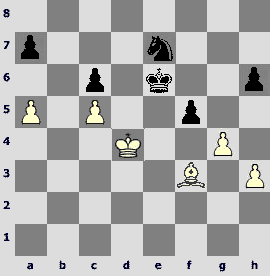
Precision to the very end! In case of f7-f6 Black should reckon with the bishop's transference to c4 and the following march of the white king to h5 via h4.
48.Ґd1 ўf6 49.Ґc2 fxg4 50.hxg4 ўe6. It's a true fortress. There's no chance to break through Black's redoubts.
51.Ґb1 ўf6 52.Ґe4 ўe6 53.Ґh1 ўf6 54.Ґf3 ўe6. Draw agreed. Ѕ–Ѕ
Introducing a strong novelty Vladimir Kramnik solved all the opening problems and achieved a total equality. Later on an urge towards the simplification at any cost has almost played a malicious joke on him. Only Kramnik's superb technique and a rather feeble technique of the computer allowed him to save half a point.
V.Kramnik (2750) – DEEP FRITZ [E51]
Game 5, 03.12.2006
1.d4 ¤f6 2.c4 e6 3.¤f3. Vladimir changes the topic deviating from the Catalan Opening that we have already got used to.
3...d5 4.¤c3 Ґb4 5.e3. By this move White displays his aspiration for a more complex play in contrast to the first games of the match where he relied exclusively on his technique.
5...0–0 6.a3. A rare line. The common continuation is 6.Ґd3.
6...Ґxc3+ 7.bxc3 c5 8.Ґb2 ¤c6 9.¦c1 ¦e8 10.Ґd3 dxc4 11.Ґxc4 e5 12.dxe5. Interesting is the following branch: 12.¤xe5 ¤xe5 13.dxe5 ¤g4 14.Ґb5 ¦f8 15.c4 Јh4 with a puzzling play. But objectively the text is stronger.
12...Јxd1+. 12...¤g4 is much more of a computer move. In this case White should sacrifice a pawn for the sake of the initiative: 13.Ґd5! ¤gxe5 14.¤xe5 ¤xe5 15.c4 Јa5+ 16.Ґc3! Јxa3 17.0–0 with a very good compensation.
13.¦xd1 ¤xe5 14.¤xe5 ¦xe5 15.Ґe2. In spite of the impetuous opening the game all the same has quickly come to an ending. This is what Kramnik was aiming at throughout the match.
15...Ґd7 16.c4 ¦e7
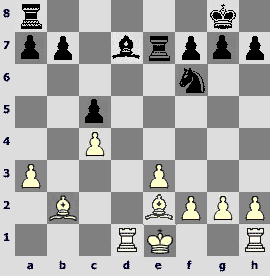
17.h4?! This original development of the rook h1 has a drawback of weakening the g3 square which makes it difficult to drive the black knight away from e4. More natural is 17.0–0, maintaining the pressure.
17...¤e4 18.h5 Ґa4 19.¦d3. 19.¦d5 Ґc6 20.¦d3 b5 21.cxb5 (dubious is 21.¦d1 b4!) 21...Ґxb5 led to the game .
19...b5 20.cxb5 Ґxb5 21.¦d1 Ґxe2 [21...Ґa4 22.¦c1 ¦b8 23.Ґa1] 22.ўxe2 ¦b8 23.Ґa1
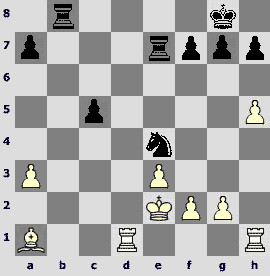
23...f5?! Another one strategic mistake by Fritz in this match. This move weakens the e5 square, unnecessarily lengthens the diagonal for the white bishop moreover the f5 pawn itself becomes a target. Stronger is 23...f6! limiting the bishop a1 and preparing the black king's entrance into the centre.
24.¦d5! ¦b3 25.¦xf5 ¦xa3 26.¦b1 ¦e8 27.¦f4?! Correctis 27.¦e5! ¦xe5 28.Ґxe5 ¦a2+ 29.¦b2 ¦xb2+ 30.Ґxb2 and in the ending B vs N Black should worry about the salvation. Now the draw is achieved by force.
27...¦a2+ 28.ўe1

28...h6! I believe it is exactly this move inseparably linked with the next one was overlooked by Vladimir Kramnik. Fortunately White still could find a draw.
29.¦g4

29...g5! 30.hxg6 ¤xf2 31.¦h4 ¦f8
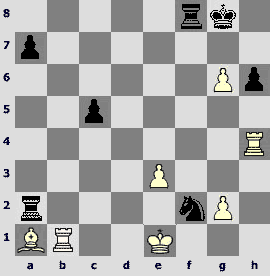
32.ўf1! It is rarely seen when the king exposes himself to the discovered check.
32...¤h3+ 33.ўe1 ¤f2 34.ўf1 ¤h3+ 35.ўe1. Draw agreed.Ѕ–Ѕ
The game swayed from side to side. Obtaining a small advantage in the ending Vladimir Kramnik began to play inventively rejecting the anti-computer academic style (I mean 17.h4). A few moves later Fritz returned the compliment choosing the double-edged and after all the dubious 23...f5?! insteadofthesolid23...f6. In the remainder of the game White committed only one inaccuracy (27.¦f4 instead of 27.¦e5), but Black can't find more than perpetual.
DEEP FRITZ – V.Kramnik (2750) [B86]
Game 6, 05.12.2006
1.e4 c5. Vladimir decides to change the character of play radically. This decision is easy to understand but is it lucky or not one may only know when the game is over.
2.¤f3 d6 3.d4 cxd4 4.¤xd4 ¤f6 5.¤c3 a6 6.Ґc4 e6 7.0–0 Ґe7 8.Ґb3 Јc7 9.¦e1 ¤c6
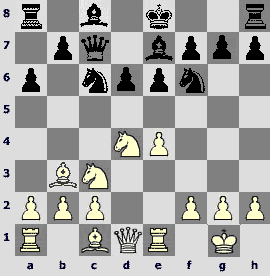
10.¦e3! An interesting and highly unusual opening idea!
10...0–0 11.¦g3 ўh8 12.¤xc6?! But the consolidation of the enemy centre isn't appropriate. Morelogicalis12.Ґe3 or 12.Ґg5.
12...bxc6 13.Јe2. Here too the bishop's development at f4 or g5 is more natural.
13...a5 14.Ґg5 Ґa6 15.Јf3 ¦ab8 16.¦e1 c5. Black has obtained good play. He isn't inferior.
17.Ґf4! Јb7! Now the e4 pawn is somewhat pinned. 17...c4 failed to 18.e5 dxe5 (even worse is 18...cxb3 19.exf6 Ґxf6 20.¦h3, and White's attack is irresistible) 19.Ґxe5 Јb7 20.¤e4 ¦g8 21.¤xf6 Јxf3 22.¦xf3 gxf6 23.¦xf6 Ґxf6 24.Ґxf6+ ¦g7 25.Ґa4 ўg8 26.Ґxg7 ўxg7 27.b3 with an extra pawn and excellent winning chances for White.
18.Ґc1. Realizing the vainness of tip-and-run attacks Fritz begins to manoeuvre.
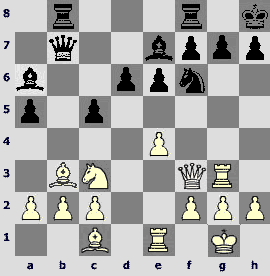
18...¤g8. Vladimir is also ready for manoeuvres! Black plans to make his king's shield more reliable.
19.¤b1. The last three moves is not a play of beginners who set up the pieces in the initial positions but interesting rearrangements.
19...Ґf6 20.c3 g6. In order to set up an obstacle on the way of the bishop c2.
21.¤a3 Јc6 22.¦h3 Ґg7 23.Јg3 a4 24.Ґc2 ¦b6?? A blunder which is basically loses the game. There was a strong positional move 24...e5! at Black's disposal. In this case White's initiative would reach a deadlock while the weakening of the d5 square isn't of a great importance as the white pieces are unable to get there. Meanwhile Black intends to transfer the bishop to e6 via c8.
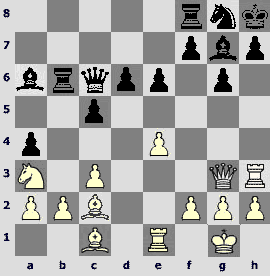
25.e5! Had this position arisen in a human game Black would have had practical chances but to fight against a computer in such a position is impossible. White's initiative develops itself while Black has weak pawns on a4 and c5 and his pieces scattered all over the board don't inspire either.
25...dxe5 26.¦xe5 [26.Јh4 ¤f6 27.Ґxa4 preserved a huge advantage as well] 26...¤f6 27.Јh4 Јb7 28.¦e1 h5 [perhaps more tenacious is 28...Јd5 preventing the knight's entrance at c4] 29.¦f3
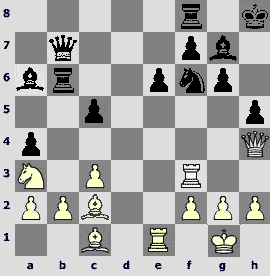
29...¤h7?! Here the knight is far from the events. Preferable is 29...¤d7, but of course Black's position is bad anyway.
30.Јxa4. White has an extra pawn and his pieces are placed much better.
30...Јc6 31.Јxc6 ¦xc6 32.Ґa4 ¦b6 33.b3. From the human standpoint more precise is 33.Ґb3, occupying the c4 square with a piece.
33...ўg8 34.c4 ¦d8 35.¤b5 Ґb7 36.¦fe3 Ґh6 37.¦e5 Ґxc1 38.¦xc1 ¦c6 39.¤c3 ¦c7 40.Ґb5 ¤f8 41.¤a4 ¦dc8 42.¦d1 ўg7 43.¦d6 f6 44.¦e2 e5 45.¦ed2 g5 46.¤b6 ¦b8 47.a4. Black resigned. 1–0
Unfortunately in this game Vladimir Kramnik lacked energy. The blunder 24...¦b6?? is the evidence of a great weariness. Summing up I'd like to say that the match has confirmed me in the opinion that a computer really calculates faster and better than a man and it also has a good theoretical base, memory and powerful multiprocessor systems. Nevertheless it doesn't raise doubt that a modern elite grandmaster is stronger in many types of positions and being properly prepared is able to regularly outplay and to beat sometimes any chess program.
